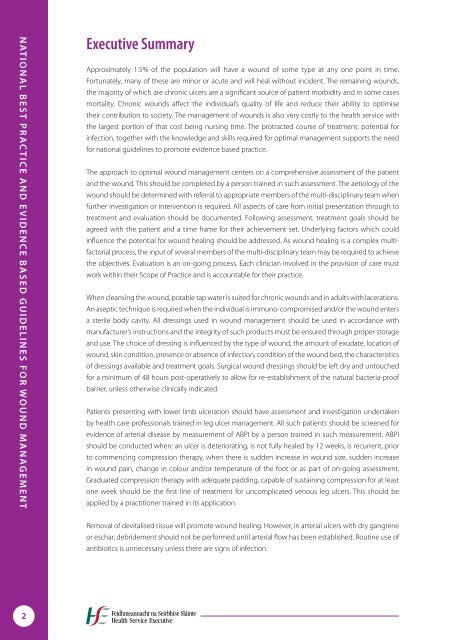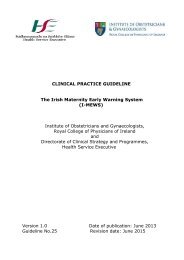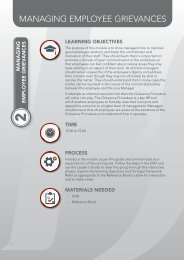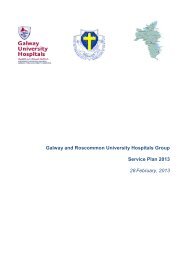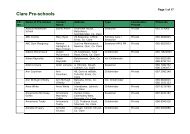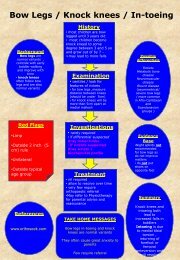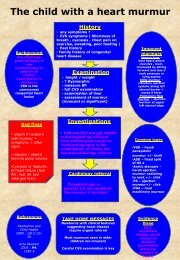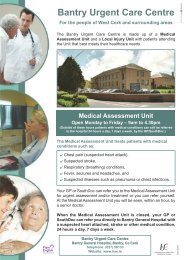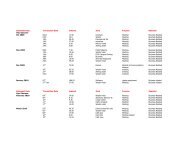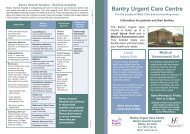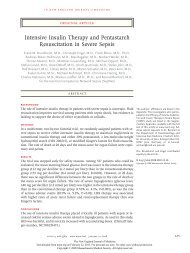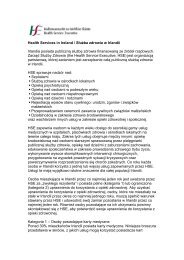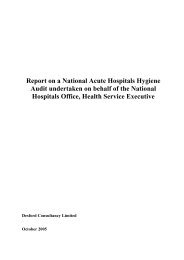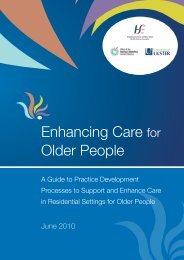National best practice and evidence based guidelines for wound ...
National best practice and evidence based guidelines for wound ...
National best practice and evidence based guidelines for wound ...
Create successful ePaper yourself
Turn your PDF publications into a flip-book with our unique Google optimized e-Paper software.
NatioNal <strong>best</strong> <strong>practice</strong> aNd evideNce <strong>based</strong> guideliNes <strong>for</strong> wouNd maNagemeNt<br />
2<br />
Executive Summary<br />
Approximately 1.5% of the population will have a <strong>wound</strong> of some type at any one point in time.<br />
Fortunately, many of these are minor or acute <strong>and</strong> will heal without incident. The remaining <strong>wound</strong>s,<br />
the majority of which are chronic ulcers are a significant source of patient morbidity <strong>and</strong> in some cases<br />
mortality. Chronic <strong>wound</strong>s affect the individual’s quality of life <strong>and</strong> reduce their ability to optimise<br />
their contribution to society. The management of <strong>wound</strong>s is also very costly to the health service with<br />
the largest portion of that cost being nursing time. The protracted course of treatment, potential <strong>for</strong><br />
infection, together with the knowledge <strong>and</strong> skills required <strong>for</strong> optimal management supports the need<br />
<strong>for</strong> national <strong>guidelines</strong> to promote <strong>evidence</strong> <strong>based</strong> <strong>practice</strong>.<br />
The approach to optimal <strong>wound</strong> management centers on a comprehensive assessment of the patient<br />
<strong>and</strong> the <strong>wound</strong>. This should be completed by a person trained in such assessment. The aetiology of the<br />
<strong>wound</strong> should be determined with referral to appropriate members of the multi-disciplinary team when<br />
further investigation or intervention is required. All aspects of care from initial presentation through to<br />
treatment <strong>and</strong> evaluation should be documented. Following assessment, treatment goals should be<br />
agreed with the patient <strong>and</strong> a time frame <strong>for</strong> their achievement set. Underlying factors which could<br />
influence the potential <strong>for</strong> <strong>wound</strong> healing should be addressed. As <strong>wound</strong> healing is a complex multifactorial<br />
process, the input of several members of the multi-disciplinary team may be required to achieve<br />
the objectives. Evaluation is an on-going process. Each clinician involved in the provision of care must<br />
work within their Scope of Practice <strong>and</strong> is accountable <strong>for</strong> their <strong>practice</strong>.<br />
When cleansing the <strong>wound</strong>, potable tap water is suited <strong>for</strong> chronic <strong>wound</strong>s <strong>and</strong> in adults with lacerations.<br />
An aseptic technique is required when the individual is immuno-compromised <strong>and</strong>/or the <strong>wound</strong> enters<br />
a sterile body cavity. All dressings used in <strong>wound</strong> management should be used in accordance with<br />
manufacturer’s instructions <strong>and</strong> the integrity of such products must be ensured through proper storage<br />
<strong>and</strong> use. The choice of dressing is influenced by the type of <strong>wound</strong>, the amount of exudate, location of<br />
<strong>wound</strong>, skin condition, presence or absence of infection, condition of the <strong>wound</strong> bed, the characteristics<br />
of dressings available <strong>and</strong> treatment goals. Surgical <strong>wound</strong> dressings should be left dry <strong>and</strong> untouched<br />
<strong>for</strong> a minimum of 48 hours post-operatively to allow <strong>for</strong> re-establishment of the natural bacteria-proof<br />
barrier, unless otherwise clinically indicated.<br />
Patients presenting with lower limb ulceration should have assessment <strong>and</strong> investigation undertaken<br />
by health care professionals trained in leg ulcer management. All such patients should be screened <strong>for</strong><br />
<strong>evidence</strong> of arterial disease by measurement of ABPI by a person trained in such measurement. ABPI<br />
should be conducted when: an ulcer is deteriorating, is not fully healed by 12 weeks, is recurrent, prior<br />
to commencing compression therapy, when there is sudden increase in <strong>wound</strong> size, sudden increase<br />
in <strong>wound</strong> pain, change in colour <strong>and</strong>/or temperature of the foot or as part of on-going assessment.<br />
Graduated compression therapy with adequate padding, capable of sustaining compression <strong>for</strong> at least<br />
one week should be the first line of treatment <strong>for</strong> uncomplicated venous leg ulcers. This should be<br />
applied by a practitioner trained in its application.<br />
Removal of devitalised tissue will promote <strong>wound</strong> healing. However, in arterial ulcers with dry gangrene<br />
or eschar, debridement should not be per<strong>for</strong>med until arterial flow has been established. Routine use of<br />
antibiotics is unnecessary unless there are signs of infection.


